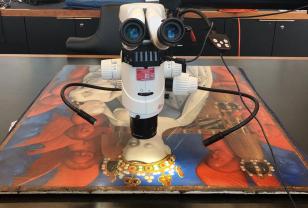This archived website 'Flemish primitives' is temporarily not being updated. Certain functionality (e.g. specific searches in the collection) may no longer be available. News updates about the Flemish primitives will appear on vlaamsekunstcollectie.be. Questions about this website? Please contact us at info@vlaamsekunstcollectie.be.
Research Virgin and Child from the Melun Diptych in J. Paul Getty Museum
One of the most celebrated works of the exhibition The Renaissance Nude at the J. Paul Getty Museum has been Virgin and Child from the Melun Diptych (ca. 1452-55) by Jean Fouquet. The painting will remain at the Getty, where it will be on view in the Museum's West Pavilion from February 5 through September 22, 2019.
The painting presents a dazzling vision of heaven with the Virgin Mary crowned and enthroned as queen and the infant Jesus on her lap. They are surrounded in glory by seraphim and cherubim, the highest order of angels. Dressed in a courtly gown with one breast exposed, the Virgin has the facial features of Agnes Sorel, the notorious mistress of the French King Charles VII. The painting is on extended loan from the Royal Museum of Fine Arts in Antwerp, Belgium.
From 28 January until 1 February 2019, in-depth research of the painting took place at the conservation studio of the J. Paul Getty Museum. Getty conservators and scientists conducted the research together with Gwen Borms, head of the conservation studio at the Royal Museum of Fine Arts in Antwerp.
With this study, the researchers are tackling art historical, material and technical issues. How is the Virgin Mary positioned, is she standing up or is she seated? Which technique has been used by Fouquet to create a marble effect? What are the materials used for the creation of the painting and how is the painting build up?







